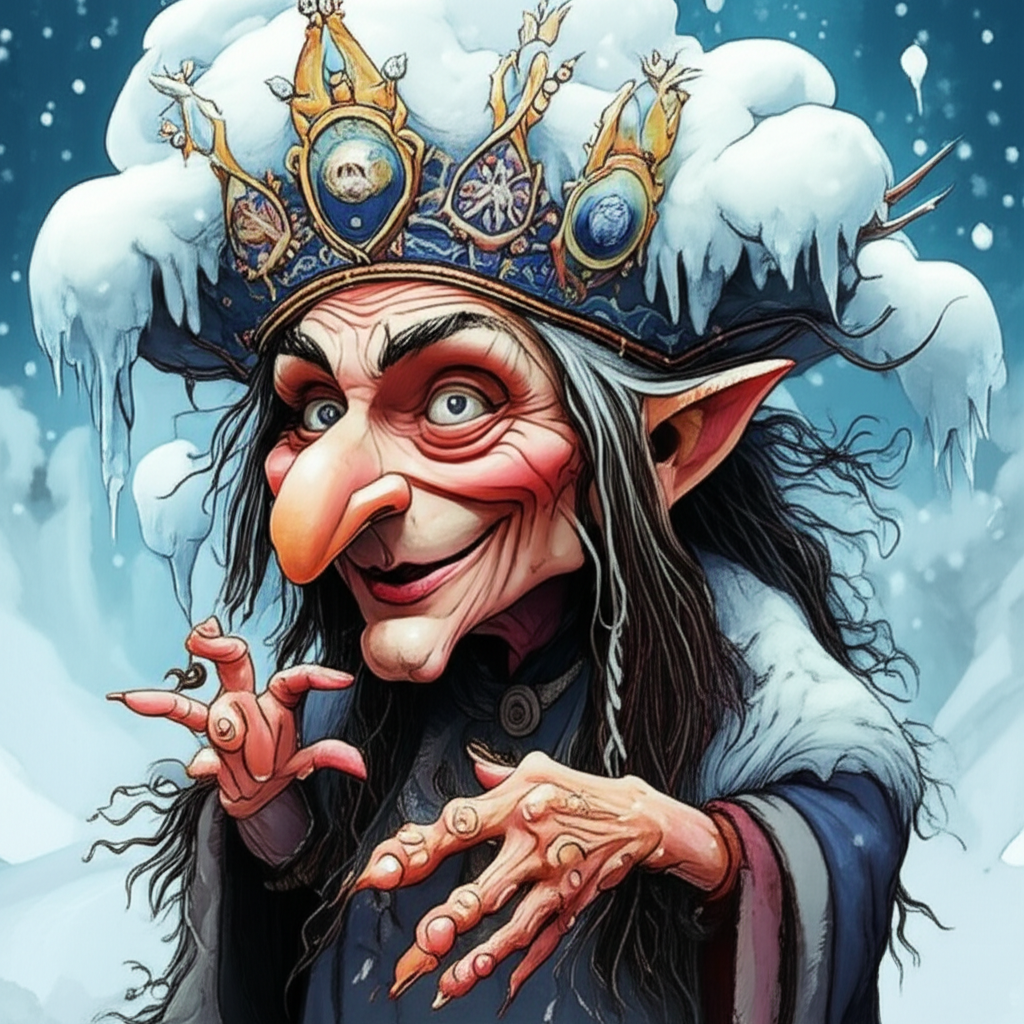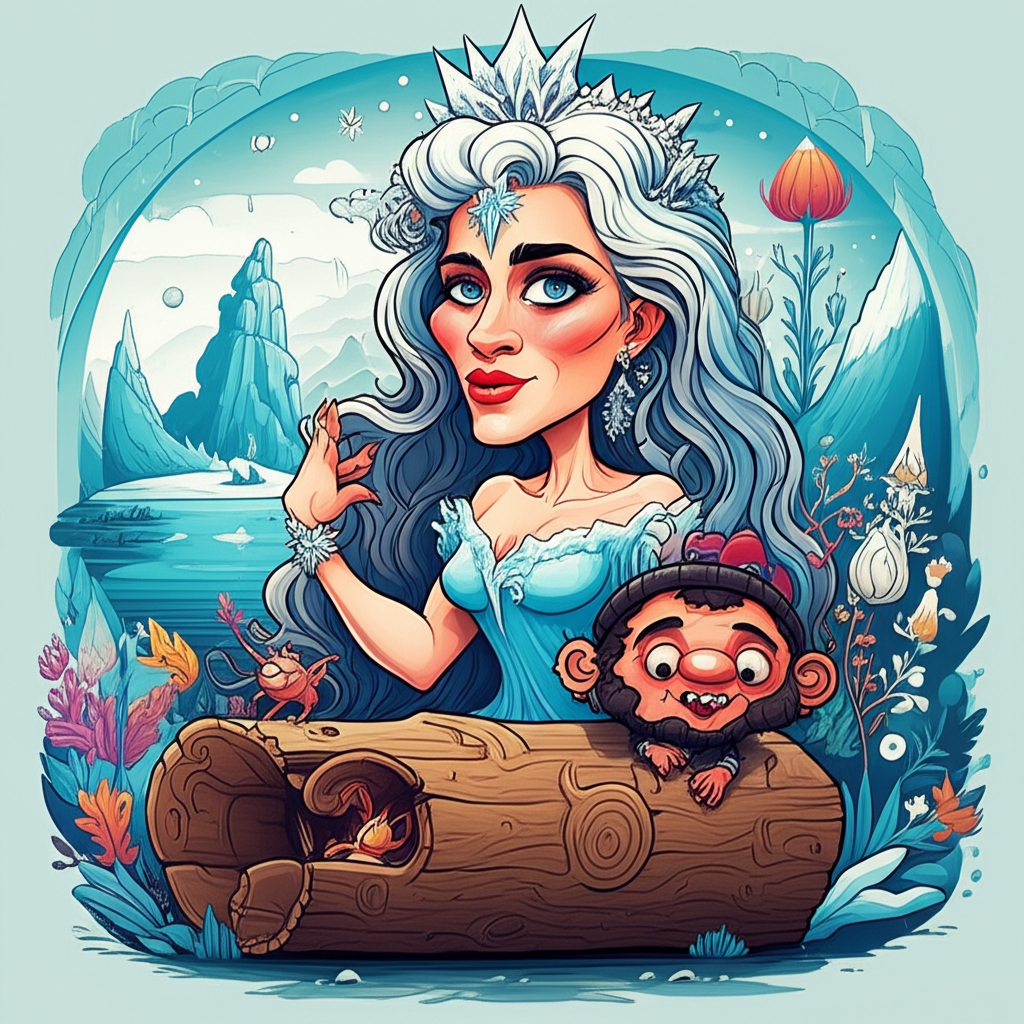
Introduction:
The tale of Baba Yaga and the Crown of Winter is a traditional story woven from the rich tapestry of Slavic folklore. Passed down through generations, primarily in Eastern Europe, this legend is a vibrant thread in the cultural heritage of people who once inhabited vast forests and faced the harsh realities of a long, cold winter. It is a story told by ancient people to explain the world around them, a world filled with both wonder and fear, and a world where the boundaries between the living and the spirit realm were often blurred. This is a story for cultural and educational understanding, not for belief or practice.
Origins and Cultural Background:
The story of Baba Yaga, like many of her kind, flourished in a cultural landscape dominated by pagan beliefs. This was a time when the natural world held immense power, and the seasons dictated survival. The vast, sprawling forests of Eastern Europe were both a source of life and a source of danger. People lived in close connection with the land, relying on its bounty for sustenance and understanding its rhythms for survival. They viewed the world through a lens of animism, believing that spirits inhabited every aspect of nature – the trees, the rivers, the wind, and the animals. These spirits could be benevolent or malevolent, and appeasing them was crucial for ensuring a good harvest, protection from illness, and the well-being of the community. Winter, with its long nights, frozen landscapes, and scarcity of resources, was a particularly challenging time, a period when the veil between the worlds was believed to be thin.
Character/Creature Description:
At the heart of this tale is Baba Yaga, a figure shrouded in mystery and contradiction. She is not a deity to be worshipped, but rather a powerful, symbolic embodiment of the wild, untamed aspects of nature. Described in various accounts, she is often portrayed as an old, witch-like woman, with a crooked nose, wild hair, and piercing eyes. She is often depicted as dwelling in a hut that stands on chicken legs, a dwelling that can move and turn at her command. The hut’s unusual feature speaks to the liminal space she occupies – not fully within the human world, and not fully of the other world. Around her hut, the forest is a tangled, overgrown wilderness, reflecting her own untamed nature.
Baba Yaga is often portrayed as a guardian of the boundaries, a gatekeeper between life and death, the known and the unknown. She might help or hinder those who seek her out, depending on their worthiness, their cunning, and their respect for the natural world. She is often associated with the elements, particularly wind and winter. She possesses a deep connection to the earth and the creatures that inhabit it, symbolizing both the power and the potential dangers of the wilderness.
Main Story/Narrative Retelling:
The Crown of Winter was said to be a magnificent circlet crafted from ice crystals, imbued with the power to control the harshest of seasons. It was a relic of immense power, capable of plunging the land into an endless winter or, conversely, ushering in an early spring. Its whereabouts were a closely guarded secret, known only to Baba Yaga.
The story often begins with a young hero or heroine, driven by desperation, courage, or a mixture of both. This character might be seeking a cure for a loved one, a way to break a curse, or simply seeking knowledge. Their journey is fraught with peril. They must navigate treacherous forests, encounter fearsome creatures, and overcome daunting obstacles.
Their path inevitably leads them to Baba Yaga’s peculiar dwelling. The hut stands, legs trembling, in the depths of the forest, surrounded by a fence made of human bones and topped with skulls. The heroine, or hero, must approach with caution, respecting the power that resides within. They might offer gifts, answer riddles, or perform tasks set by Baba Yaga. These tasks are often symbolic, testing their character and their understanding of the natural world. They might be asked to sort grains, weave intricate tapestries, or to fetch water from a well guarded by mythical beasts.
In some versions, the hero/heroine must serve Baba Yaga, working tirelessly to earn her favor. She might order them to sweep the yard with a broom made of fire, or to tend to her animals, all the while testing their patience and their resilience.
Ultimately, through their perseverance and their ability to demonstrate respect and understanding, the hero/heroine earns Baba Yaga’s trust, or at least her begrudging respect. In a moment of vulnerability, or perhaps as a test of their true intentions, Baba Yaga reveals the location of the Crown of Winter. She might offer it freely, warn them of its dangers, or even set them on a final, perilous quest to retrieve it.
The climax of the story involves the hero/heroine’s encounter with the Crown of Winter. They must learn to wield its power wisely, understanding the delicate balance of nature. They must decide whether to embrace the winter’s strength or to seek a thaw, understanding that both are essential for life. In the end, they use the Crown to restore balance, ensuring the survival and well-being of their people, or perhaps, to find a place for themselves in the world.
Symbolism and Meaning:
The story of Baba Yaga and the Crown of Winter is rich with symbolism. Baba Yaga herself represents the wild, untamed aspects of nature, the unpredictable power that exists beyond human control. She embodies both fear and wisdom, acting as a gatekeeper to knowledge and a test of character. The hut on chicken legs symbolizes the threshold between worlds, a place of transformation and initiation.
The Crown of Winter symbolizes the cyclical nature of the seasons, the interplay between life and death, and the power to control the natural world. It can represent the harshness of winter, the challenges of life, and the potential for rebirth and renewal.
The hero/heroine’s journey represents the human experience of overcoming obstacles, seeking knowledge, and striving for balance. The tasks they undertake are often symbolic of the challenges of life, the need for resilience, and the importance of understanding the world around them. The story highlights themes of courage, perseverance, and respect for nature.
Modern Perspective:
The myth of Baba Yaga and the Crown of Winter has resonated through the centuries, finding new life in modern literature, film, and games. She appears in countless adaptations, from animated movies to video games, often as a complex and morally ambiguous character. Modern interpretations often explore her roles as a guardian, a mentor, and a force of nature.
The story continues to fascinate modern audiences because it taps into timeless themes of good versus evil, the struggle between order and chaos, and the importance of understanding the natural world. It encourages us to confront our fears, to seek knowledge, and to appreciate the cyclical nature of life. The story provides a lens through which we can explore the power of folklore and the enduring influence of the past.
Conclusion:
The tale of Baba Yaga and the Crown of Winter, like all folklore, is a product of its time. It is a cultural artifact that reflects the beliefs, fears, and values of the people who created it. It is a reminder of the power of storytelling to shape our understanding of the world, to preserve history, and to connect us to our cultural heritage.
It is important to remember that these are stories for cultural and historical understanding, not for belief or practice. As Muslims, we recognize that only Allah, the Almighty, is the true Creator and Sustainer. Our faith teaches us to seek knowledge, to appreciate the beauty of the world, and to learn from the wisdom of the past. The stories of other cultures, like that of Baba Yaga, can provide insights into human nature, imagination, and the universal quest for meaning, but must always be understood within the context of their own cultural and historical frameworks. They are a testament to the enduring power of the human imagination and the richness of the storytelling tradition.





